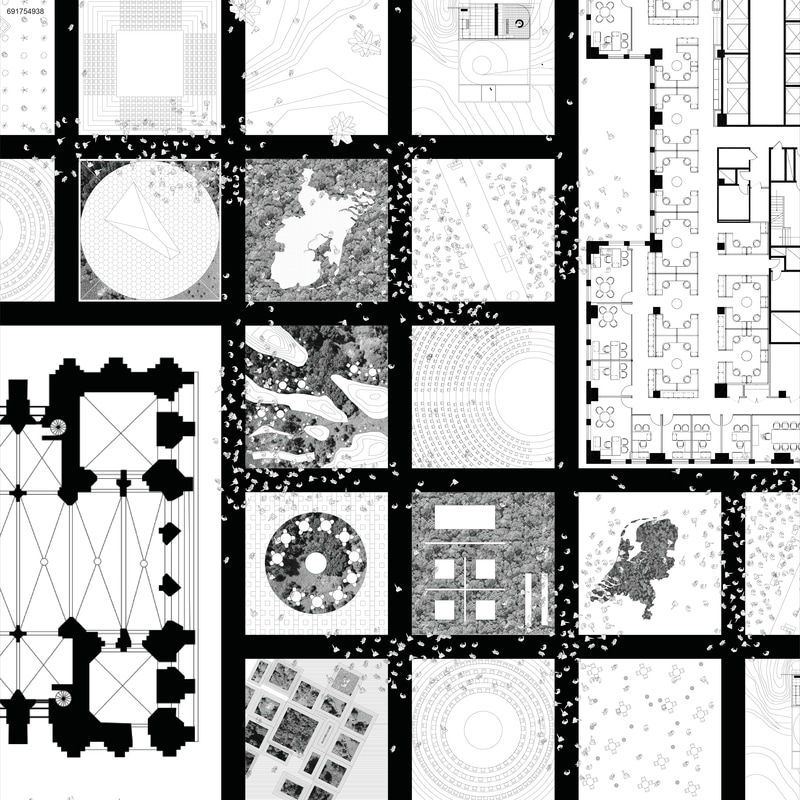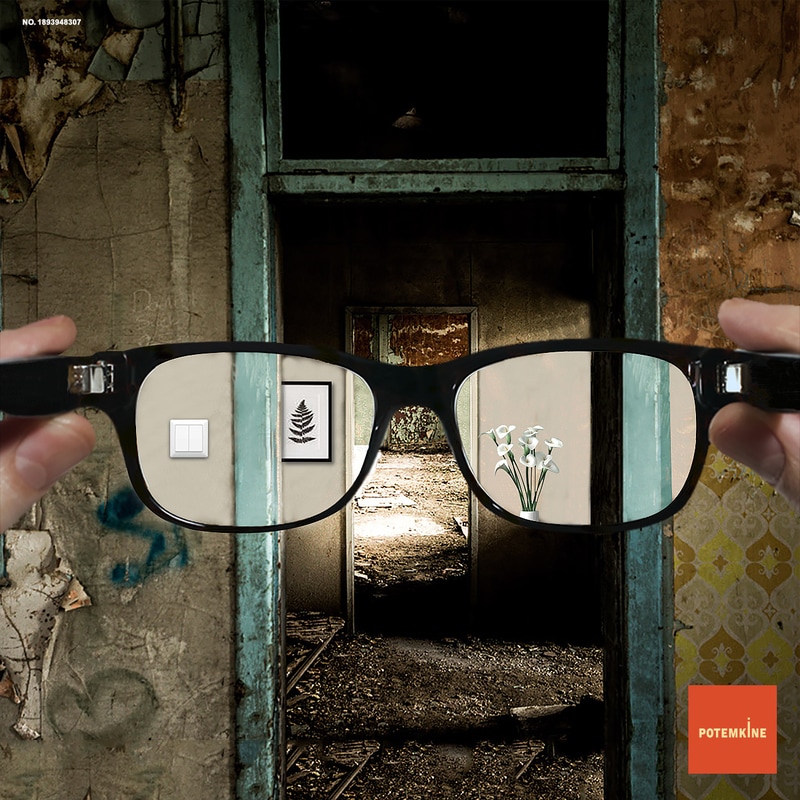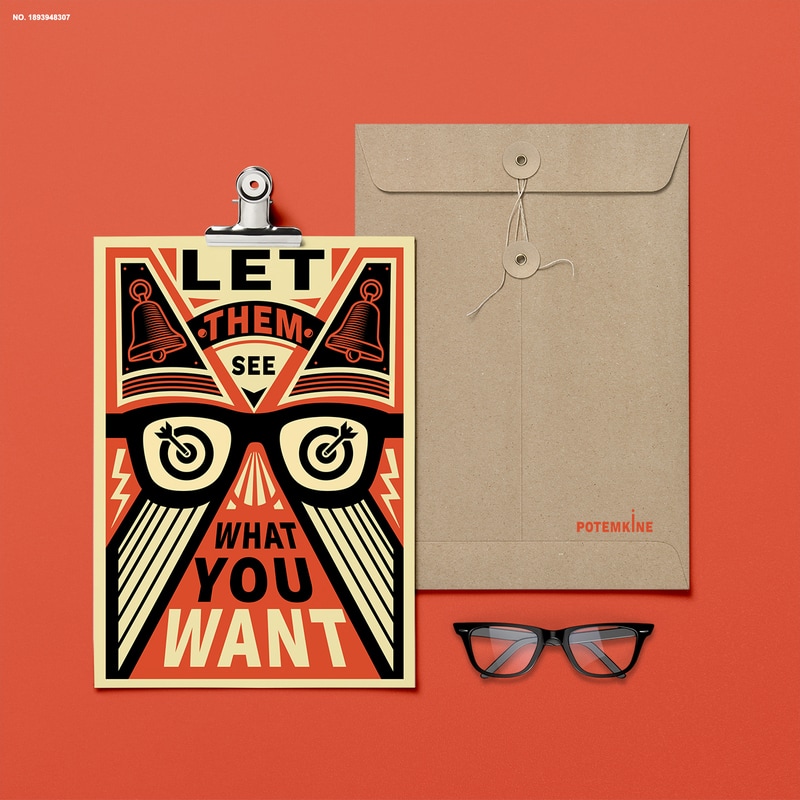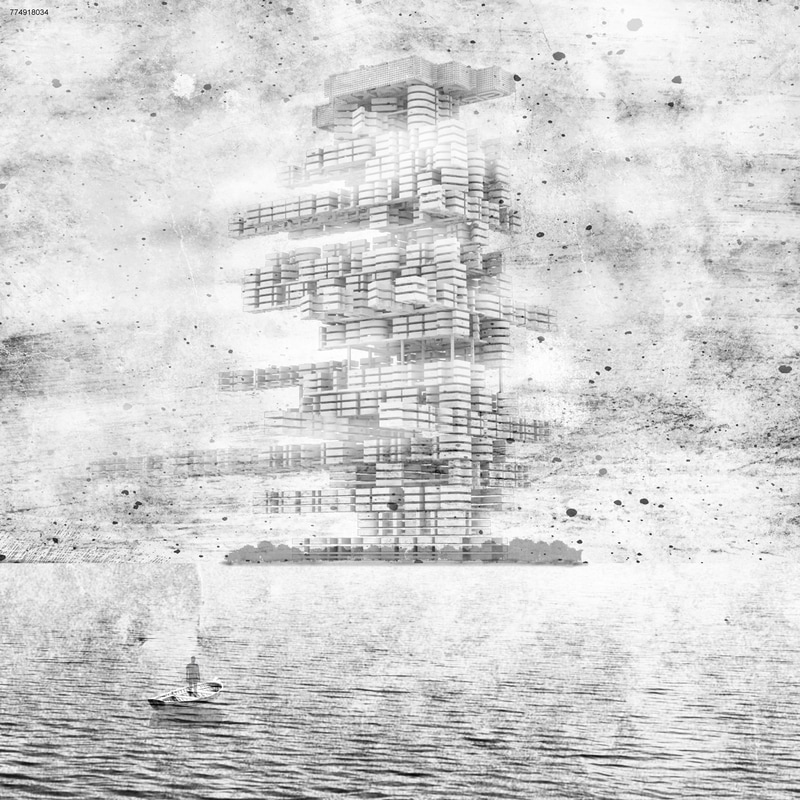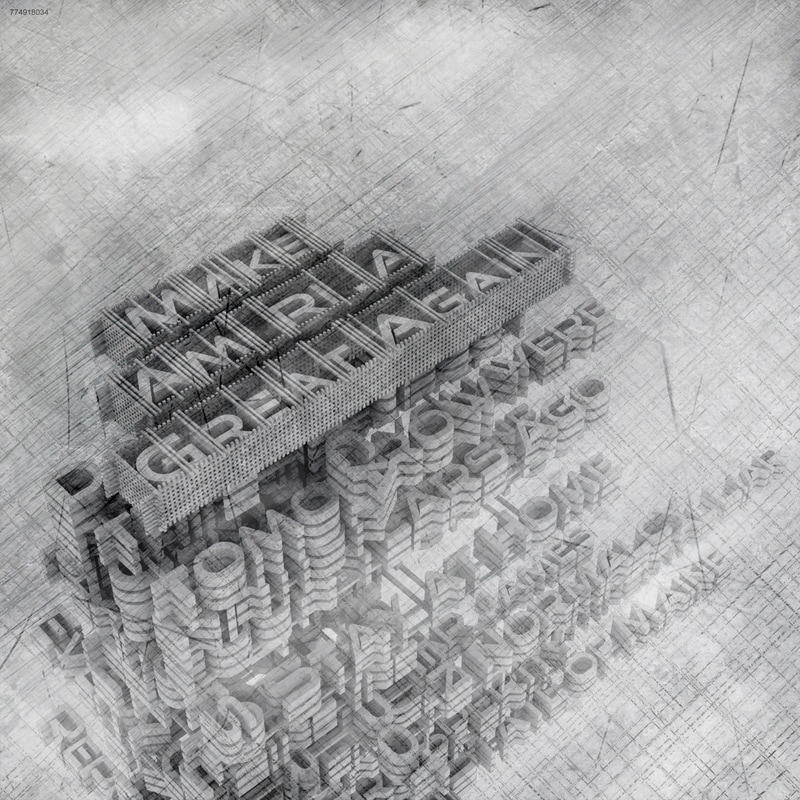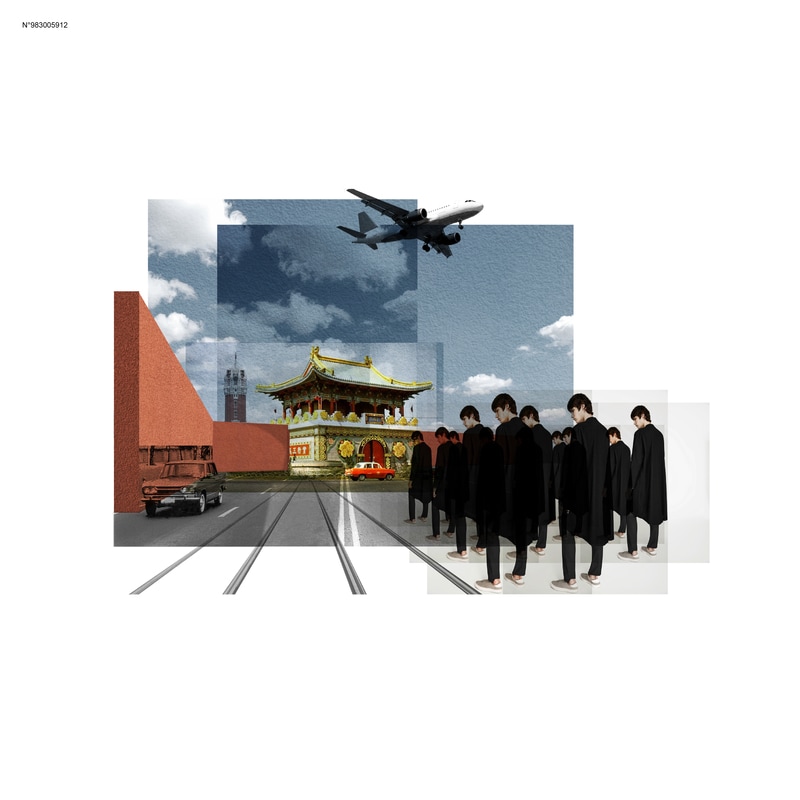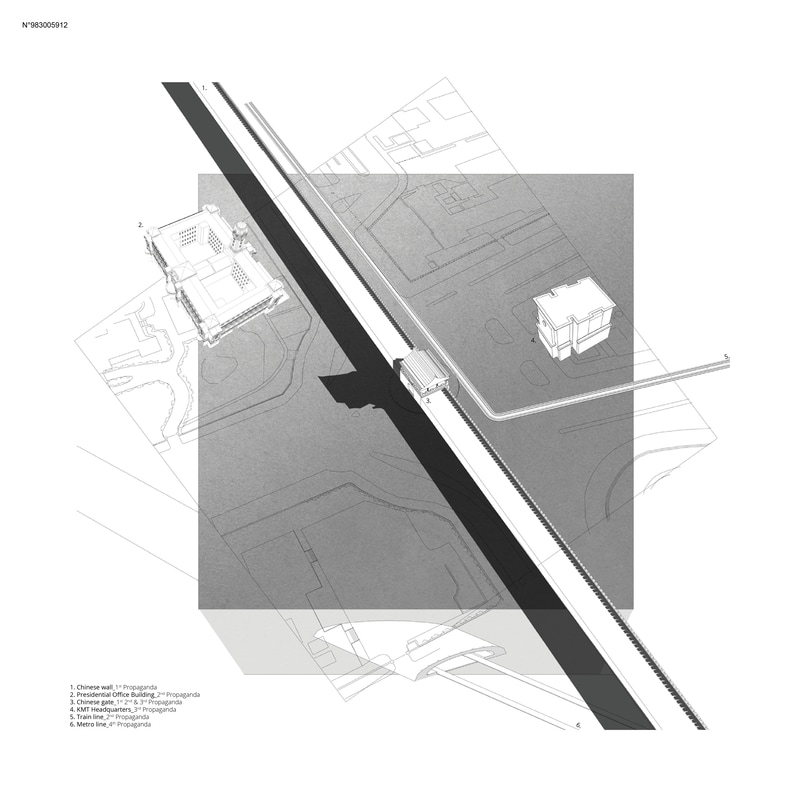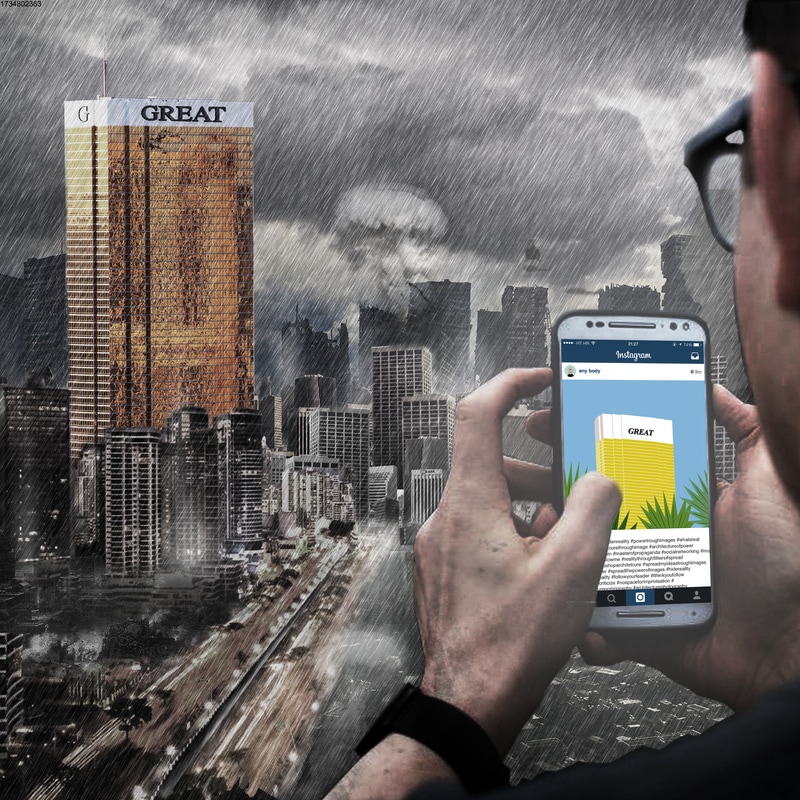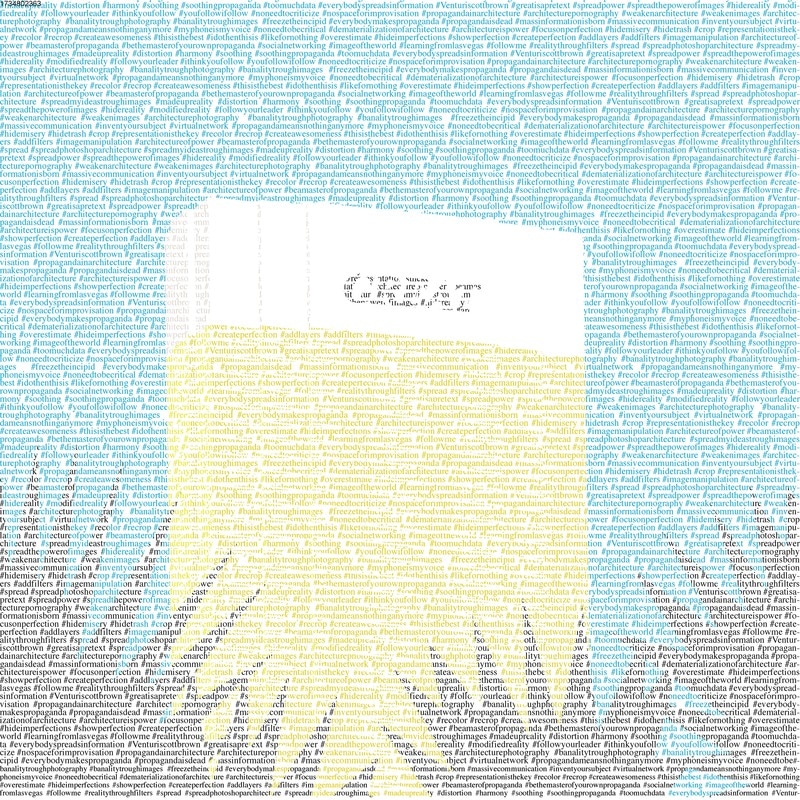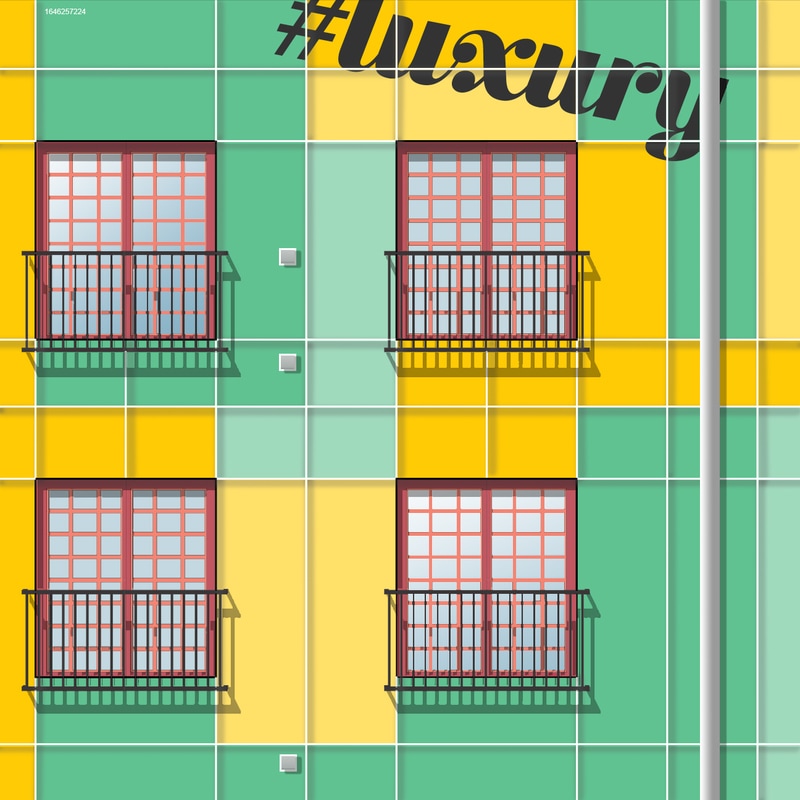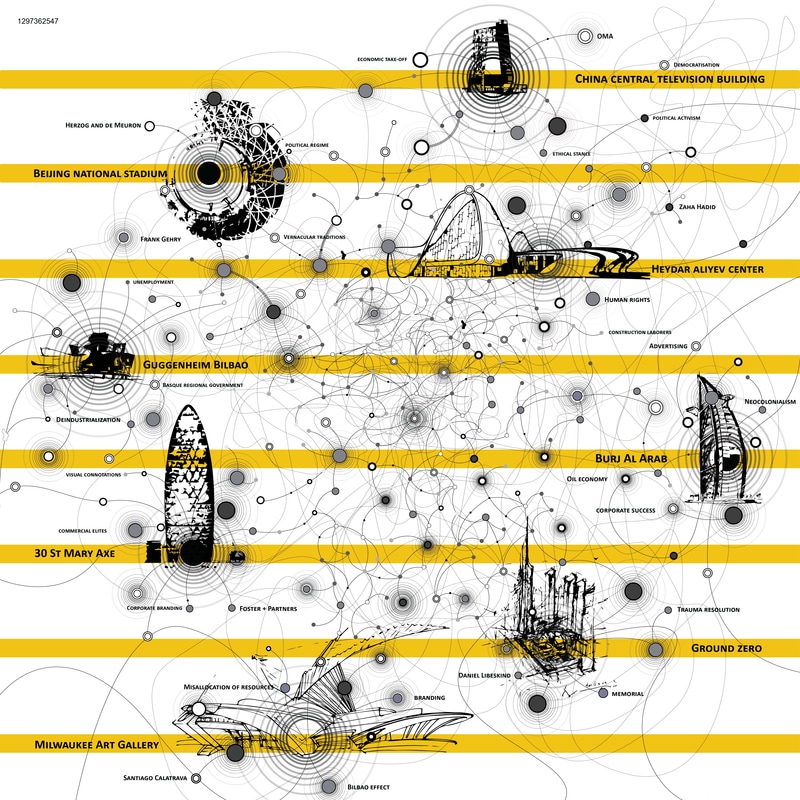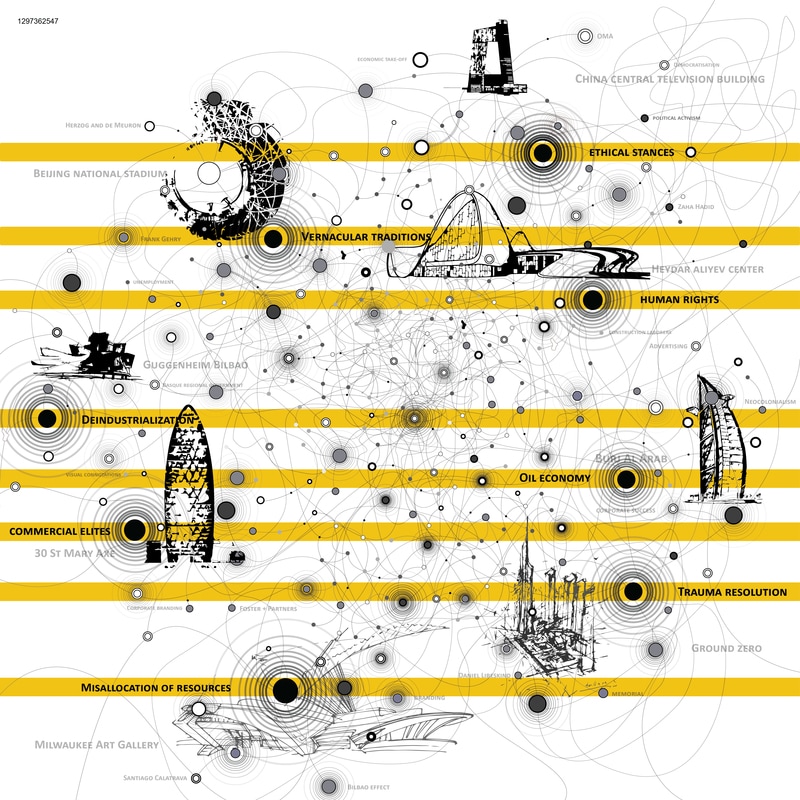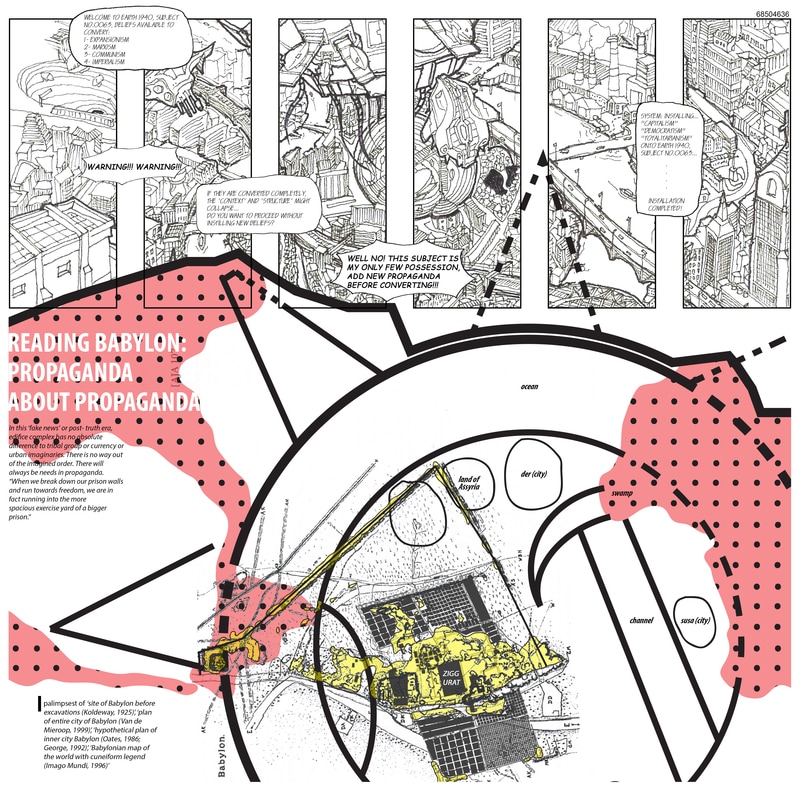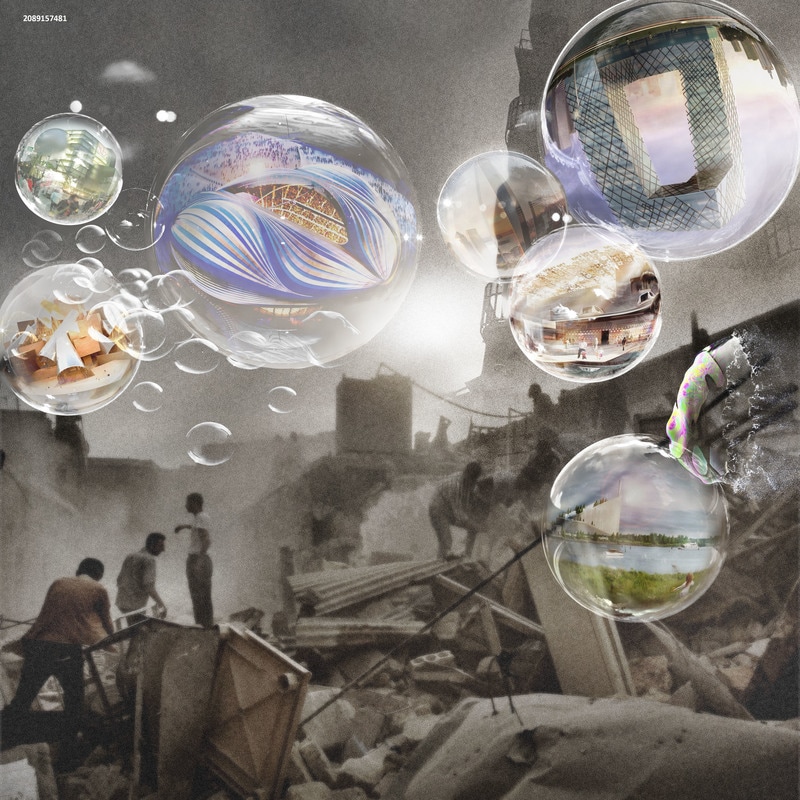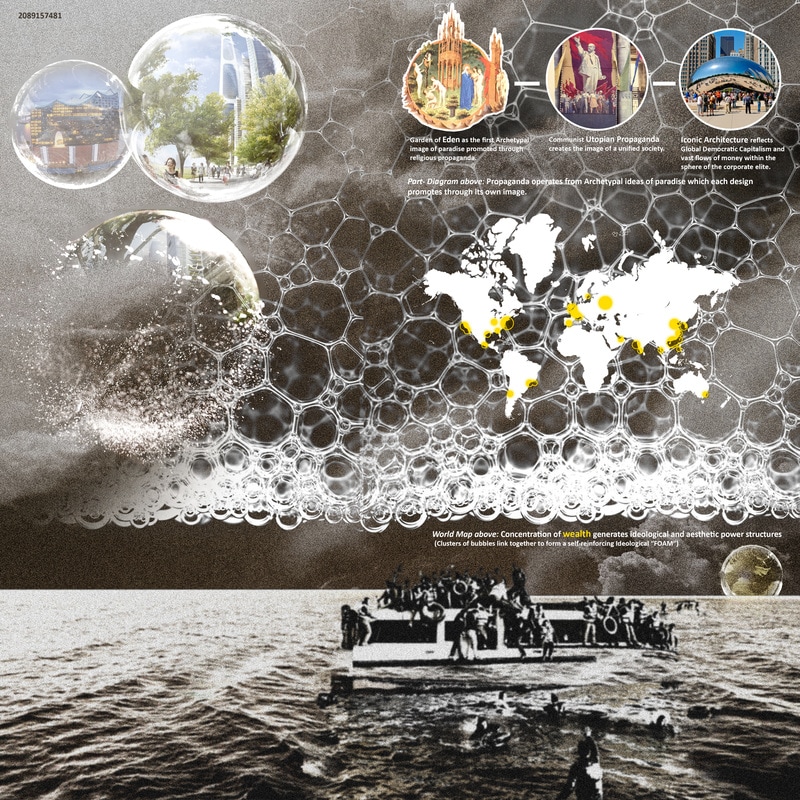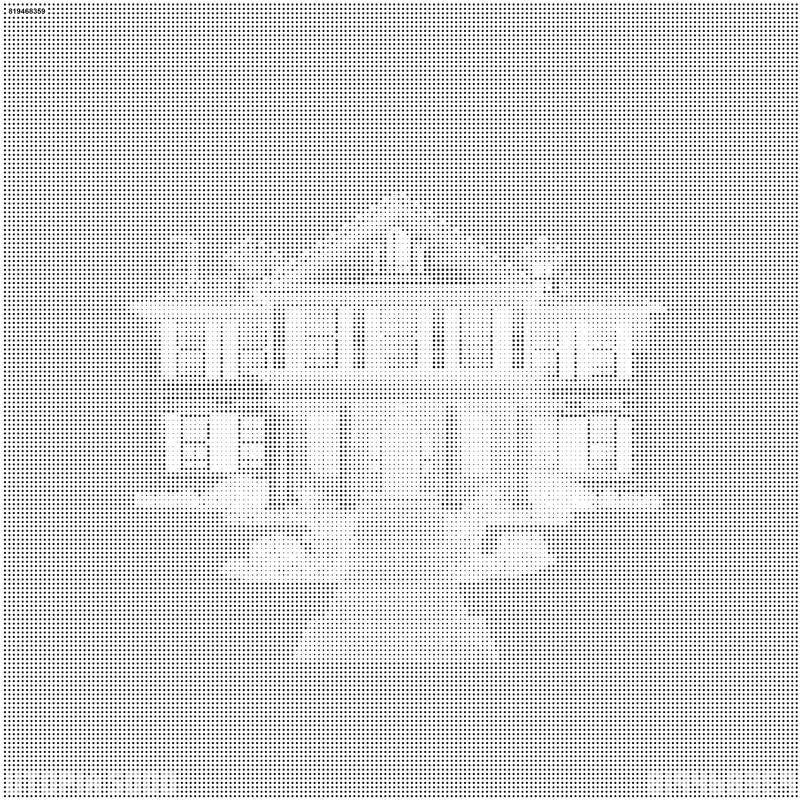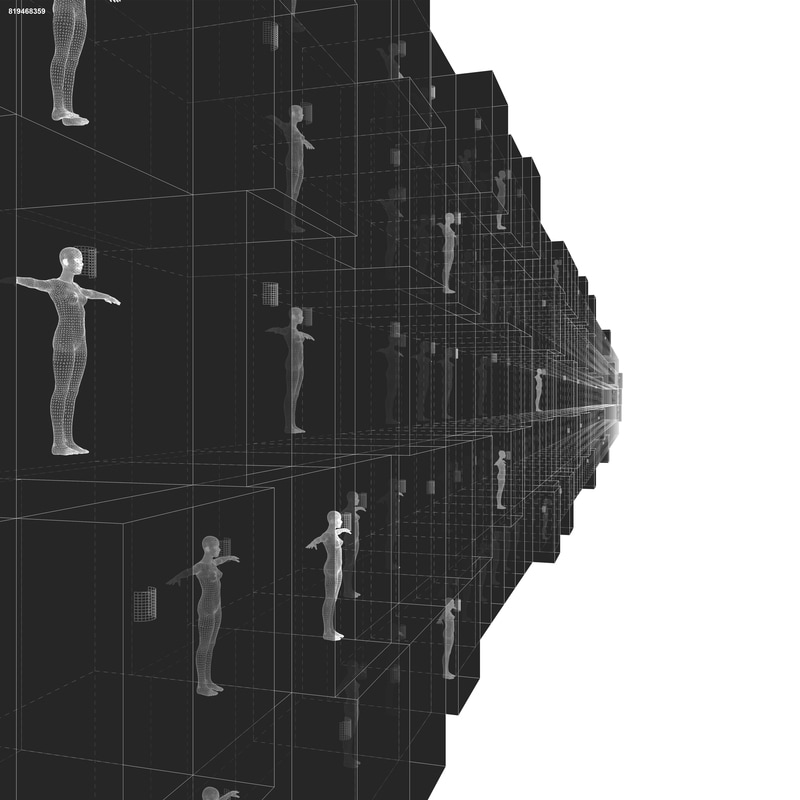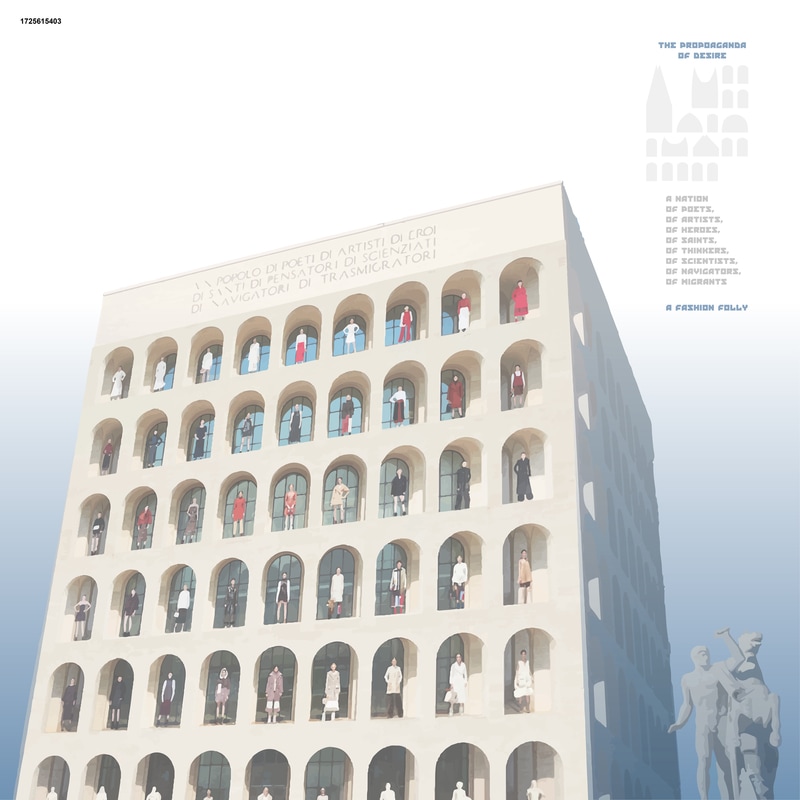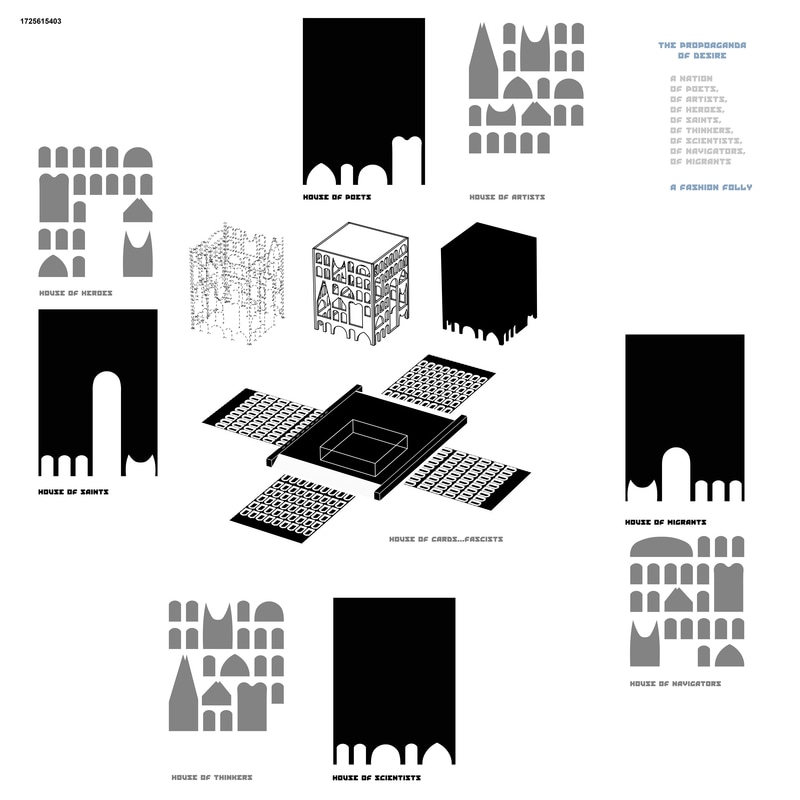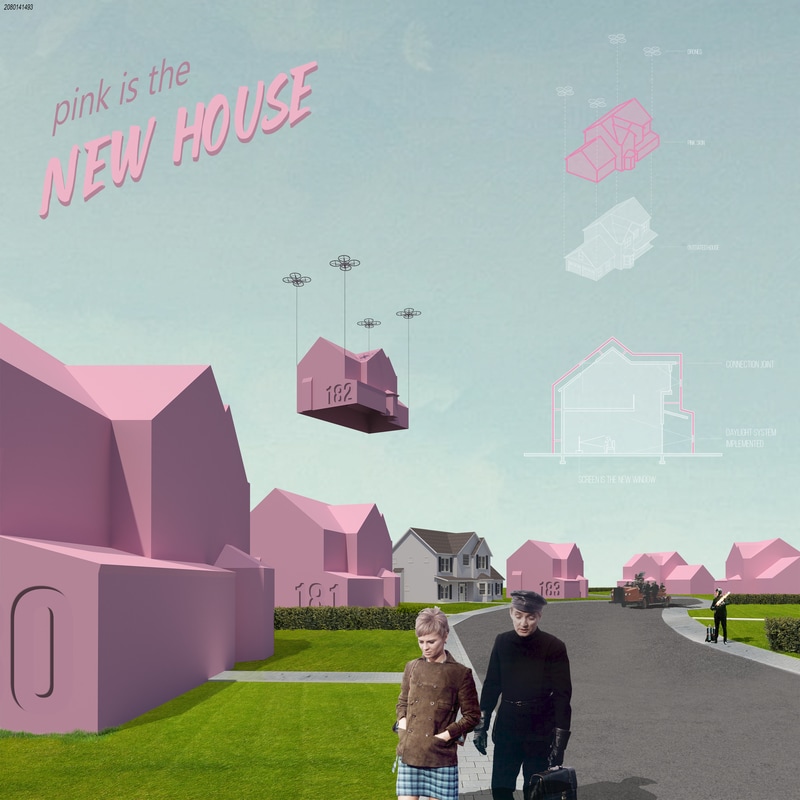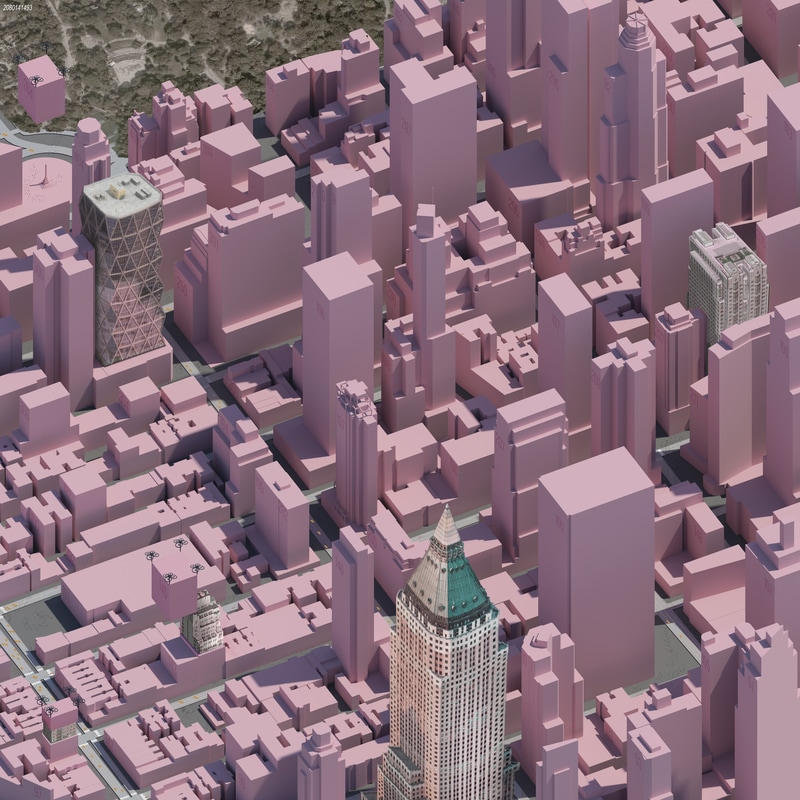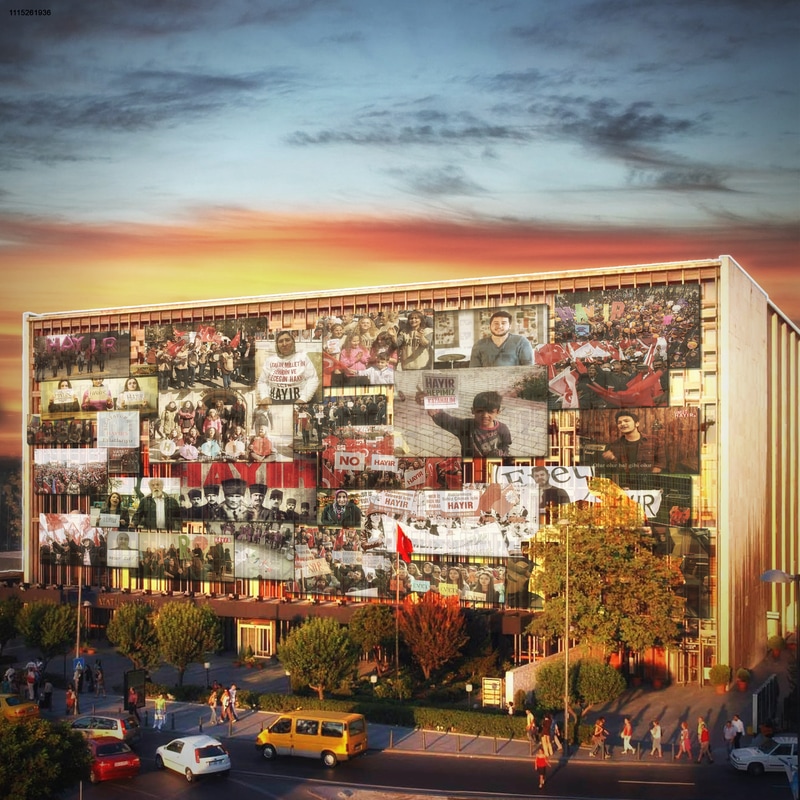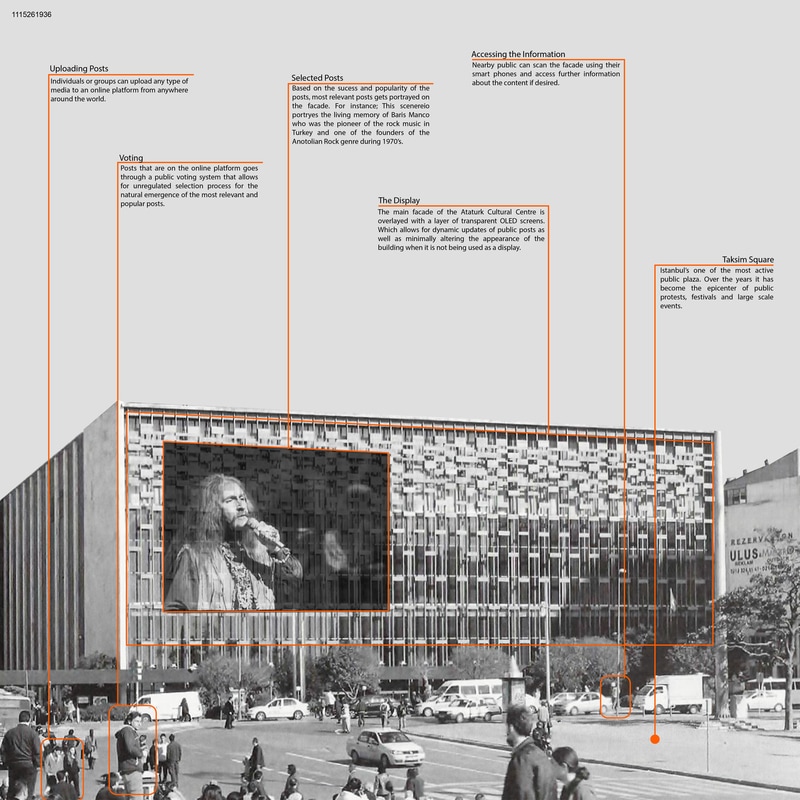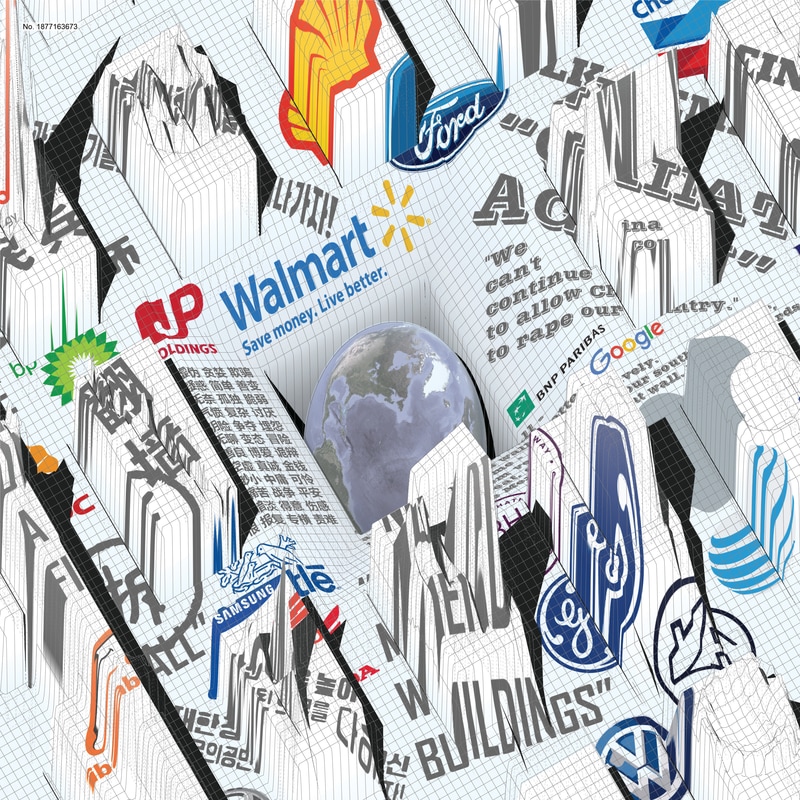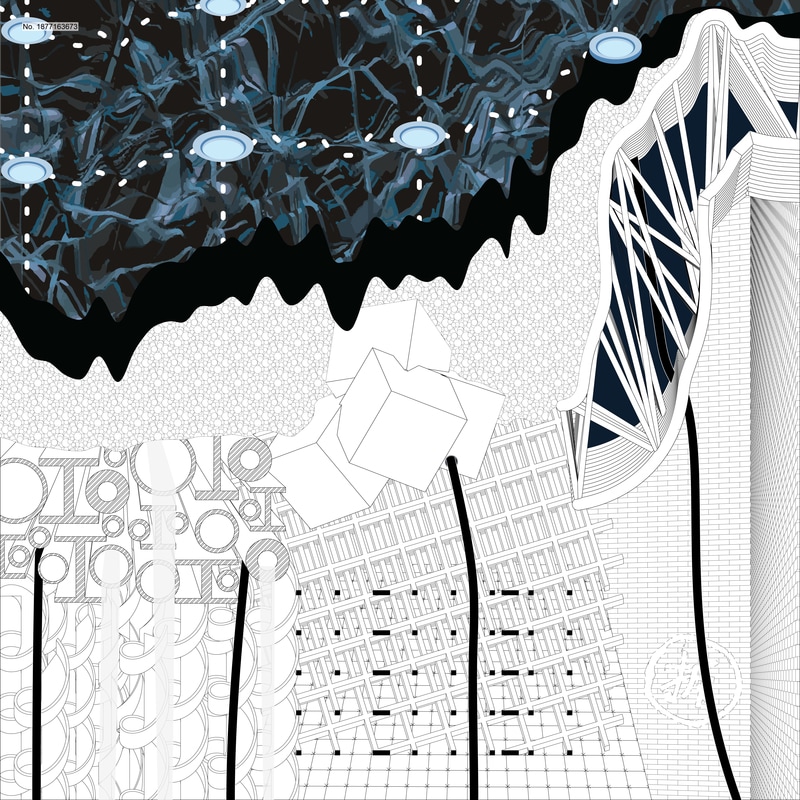[ FINAL RESULTS ]
FIRST PLACE
DAVIDE MASSERINI
Milan, Italy
Device as space, space as device
A propaganda of spaces
|
Device - Middle English, from Old French devis, division, wish, and Old French devise, design, both from Latin dīvīsus, dīvīsa, past participle of dīvidere, to divide, separate
Mankind’s growth doesn’t seem to stop, Earth has reached its full capacity already in 2030. Consequences of this humungous expansion could be seen all around, coral reefs disappearing, glaciers melting, sea levels increasing, climate changing. Today, March 3rd 2050, marks a turning point in History, we witness the very first attempt of human kind in trying to restore what we carelessly destroyed through the ages. Oil based means of infrastructure have been banned, people will get back on their feet from now on. |
This move sets a milestone for generations to come, a propaganda of spaces that is not willing to stop, the reclamation of space as the new leitmotif for further development.
In order to avoid extreme walking distances between different services and destinations, what once used to be called “streets”, have now been converted in a fertile ground of activities. Placed directly “next door”, the common Wall Street business man can now spend his breaks at the Funnel, enjoying his best singer or take a nap at the Garden of Eden, kissed by a gentle breeze. Space becomes the new man’s device for evading the routine. A device conceived at a different scale, thought to give the best experience at every given moment. |
The “devices” are several and differ both in shape and function, they are complementary, still independent. Three are the main typologies: PERFORMING, RESTING and BASIC NEEDS.
Following these three categories, the space-devices are declined in different environments, following the typology they are part of the space has been designed differently - dancing, singing, contemplating at the Mirror Pond, at the Up- Down Ziggurat, at the Funnel, at the Mountain - , the typology of resting - sleeping, napping at the Hilly Lands, at the Metropolitan House, at the Garden of Eden -, the typology of basic needs - personal hygiene, eating, cooking, mating at the Sweep, at the Fun Palace, at the Asteroids -. |
SECOND PLACE
PAUL NIVELLE VICTOR DRUOT
Bordeaux, France
POTEMKINE
|
Propaganda creates a movement, a trend in order to persuade, indoctrinate groups of people. Propaganda mutes the opposition, lies to the people and undertake constructions that will ruin the country but that will glorify its power.
All these methods reduce people's freedom and always hides a dark evil. Let's call a spade a spade and be faithful to the meaning of words so as to never forget the horrors brought on by propaganda. However, all architectural projects are engaged and carry a message without necessarily being architectural propaganda (for instance Beaubourg & HighTech). Therefore the answer to this topic is rather more sarcastic and cynical. It oers a product that could change the architectural face of the town/country the tyrant rules in. Erase a war zone or a building, make people believe a site such as Aleppo has never been destroyed. Censor the architecture that was thought to remain over the years and that was inescapable. Two references feed this project, on the one hand the village of Potemkin, used at the peak of propaganda that spoke of architecture (of false architecture). On the other hand, a reference to 'They Live' a film by John Carpenter in which the protagonist finds glasses that reveal all the propaganda hidden in advertisements and visuals seen by the population. The screens and even the VR glasses create the wallpapers, the sceneries of fake villages and industries in order to create the illusion that all is well in the world. The Potemkin glasses are therefore the perfect solution for tyrants to silence the people and show them only what they most wish to see. The first image shows how the glasses work. The second image represents a letter addressed to a head of state in which can be seen an ad for the glasses in a graphical constructivist style. It is important to anticipate the distortions brought on by technology in order to allow people not to be blind to what is happening. |
THIRD PLACE
LUO PENG
Beijing, China
|
We...are...the...slowest...writers...in...the...world...
Our...only...lettering...is...architecture... For...thousands...of...years...we...have...been...writing...a...book...which...contains...our...only...history... We...live...in...the...book...and...all...our...lives...are...connected...with...it... Some...of...us...are...maintainers...repairing...old...texts...in...this...book...the...others...are...creators...building...new...words... which...are...figured...out...by...the...chief... We...are...constructing...new...characters...now...and...we...will...know...what...they...mean...soon... |
HONORABLE MENTIONS
GÉRALDINE THOMAS BENJAMIN HENRY
Tours, France
The gate of propagandaWalls have been defining cities for ages. There gates are strategic in both defensive and symbolic terms. In Taipei, the wall has been destroyed but some of its gates remain. They have preserved their function of symbol through history and are representatives of the politics led in the Taiwanese capital since 1882.
First propaganda. In 1882, the Chinese government, concerned by a French occupation of Taiwan, turns its attention to Taipei after being disinterested for more than two centuries. With the intention to export the Chinese values to Taiwan, they initiate the construction of a traditional Chinese city, surrounded by walls and opened with five gates. Second propaganda. After the Sino-Japanese war, Taiwan becomes a Japanese colony. In 1905, three gates remain from the destruction of the wall : the Chinese propaganda has disappeared. On the land formerly occupied by the wall, the new occupant creates a boulevard, a railway and administrative buildings. Taipei becomes a colonial Japanese city based on western styles and the absence of the wall becomes the spine of its development. Third propaganda. The arrival of Chiang Kai Check in Taiwan involves a new Chinese era in Taipei which result in its sinicization and the imposition of the martial law. The remaining gates are not considered to be Chinese enough and are consequently decorated according to the more ostentatious Chinese traditions. In an era of repression, the modification of the gates can only be regarded as a political propaganda. Fourth propaganda. The global age in which Taipei is actively involved, has led to a last addition to the history of propaganda that occurred on the gate site since 1882. The former wall layout is now crossed by subway lines, followed by highways and advertise a global way of life. The Chinese wall and gates have always been the support of a political ambition to modify the identity of the population of Taipei. « In the diachronic transformation of wall to boulevard and boulevard to subway, (...)find the ideological transformation of the imperial into the colonial and the colonial into the global. »1 The anachronistic depiction of the fourth propagandas as a single project is a fictional and a physical representation of a complex identity. Although being absurd, this project illustrates a current urban attitude in Taipei: Taiwanese leaders are working on memory and preservation policies, considering the consecutive propagandas as a part of an assumed identity. |
STEFANO TEKER SAMUEL AMORY
Brussels, Belgium
# F I L T E R E D R E A L I T Y
|
#newera #technology #virtualworld #spread #spreadarchitecturethroughimage #everyonecreatesicons #hiddenreality #banalitytroughrendering #banalitytroughphotography #banalitytroughimages #freezetheincipid #everybodymakespropaganda #propagandaisdead #massinformationisborn #massivecommunication #inventyoursubject #virtualnetwork #propagandameansnothinganymore #myphoneismyvoice #noneedtobecritical #dematerializationofarchitecture #architectureispower #focusonperfection #hidemisery #hidetrash #crop #representationisthekey #recolor #recrop #createawesomeness #thisisthebest #idothenthisis #likefornothing #overestimate #hideimperfections #showperfection #createperfection #addlayers #addfilters #imagemanipulation #architectureofpower #beamasterofpropaganda #bethemasterofyourownpropaganda #socialnetworking #imageoftheworld #learningfromlasvegas #followme #realitythroughfilters #spread #spreadphotoshoparchitecture # spreadmyideastroughimages #madeupreality #distortion #harmony #soothing #soothingpropaganda #toomuchdata #everybodyspreadsinformation #Venturiscottbrown #greatisapretext #spreadpower #spreadthepowerofimages #hidereality #modifiedreality #followyourleader #ithinkyoufollow #youfollowifollow #noneedtocriticize #nospaceforimprovisation #propagandainarchitecture #architecturepornography #weakenarchitecture #weakenimages #architecturephotography # follow # like # follow #follow #share #share #like #share #crop #recolor #recrop #createperfection #share #follow #like#like #share #crop #recolor #recrop #createperfection #share #follow #like #...
|
# T h i s i s p r o p a g a n d a
CAROLINE BOZZI
Cincinnati Ohio, United States
|
The developers selling apartments, to young professionals, empty nesters and every other profile in between, focus on portraying ideals of health and walkability, local culture and ecology, history and wealth. The street is lined with banners that are plastered with the neighborhood marketing campaign, “Welcome to East Springdale.” Our views vanish across the plaza adorned with fountains and café tables. The complete streets are equipped with bike lanes and accessible bus stops. And yes, we checked all the boxes.
Even to a visitor it’s a powerful motif and a spectacular view of libraries, community centers and balanced development of jobs and housing. For a split second, you might even believe that maybe people don’t have it so bad here. It’s not until you realize that this apartment building looks at same as the one down the street, across the street and the same as the ones in West Springdale. We are left with a 21st century replica of catalogued homes endlessly vomited out with the misleading titles luxury, deluxe, and high-end. This apartment building is placeless. It is profit-driven and the construction is made possible from bank loans that are only processed if the development is proven to be successful. In fact, there is no room for uniqueness. And once you live inside, you learn there is inadequate insulation and sound barriers. The buildings are designed for developers, who never live in or occupy the buildings. Maybe this quality of life is better than the life suburban sprawl supported. Maybe? But genuine quality is replaced for buildings that merely give the impression of lively neighborhoods. Construction quality has plummeted as buildings are constructed with wood studs, thin brick and fiber cement panels that rely on caulking for moisture protection. Although statistically it looks like the neighborhood is in a constant state of rapid “growth,” are the developers leaving us better off or in a perpetual cycle of simulating the “American Dream?” |
CRISTINA ANASTASE
Bucharest, Romania
|
The iconic structures are “poignant reminders of social visibility”*.
They act as spatial and temporal reference points; as high degree nodes in a 4 dimensional network, which connects political regimes - to conflicts - to economic strategies - to unemployment in deindustrialized cities - to “peak oil” fears - to neocolonialism - to business decisions - to commercial elites - to symbols of power - to advertising - to high skilled laborers - to symbols of sophistication - to tourists itineraries - to service laborers - to maintenance specialists - to elevator technicians - to janitors - to aspiration of remapping one’s place in the world. As the most visible nodes in this network, outshining and, sometimes, intentionally or inadvertently, outright camouflaging their neighbors, the iconic structures are the ultimate propaganda instruments. The question that arises is whether there can be found a way of tweaking the visibility of the nodes in this network. If the iconic building is such a powerful instrument of filtering, hiding, or displaying information through the very nature of the process through which it is born, could it consciously highlight neighbors and act as a social activist? Perhaps the answer is as convoluted as the network itself, but the quest of repurposing such a propaganda instrument to highlight a different set of ideas is rooted in understanding the mechanisms behind the network, the inherent capacity of the iconic building to organize the time and space and its potential to alter the network. *Donald McNeil, “Firms, fame and urban form” Drawing: visualization of the network |
KAR KHENG GAN
Kota Tinggi, Malaysia
Reading Babylon: Propaganda about Propaganda
|
Throughout history, architecture has been used as a propagandistic tool to intentionally communicate ideas of power and politics, creating a social narrative due to its duration of exposure on the societies. Architecture has a way of influencing viewers as well as being influenced by the current political aspirations of those intent on using design as imposition of will. Often, Adolf Hitler, Benito Mussolini, Kim Jung Il, Saddam Hussein and Mao Zedong, are metonym for the ‘villains’.
Regardless of the negative connotation for its common use in promoting exclusion and nationalism throughout history, Reading Babylon: Propaganda about propaganda tries to look at architectural propaganda through reimagining the definition of propaganda and reinterpret notion of our current ‘institution’ as an ‘imagined order’. Propaganda by definition is the “method of spreading biased or misleading information with the purpose of injuring or promoting an institution, cause or person”. However, we might argue that the ‘information’ we now receive so freely, in the post- truth era, are those that are selected to fit in with our already existing concepts of what actually constitutes the ‘real world’ or at least the cinematic, pre- narrated, real world. More often than not, what is being promoted is a highly filtered version of a particular selected reality which has now turned into a shared experience of reality, or for instance, we could called it, the ‘inter-subjectivity of an imagined order’. Our perceptions towards the world and how it works, the truth that lies within the implementation of law, money, religions and nations, are then questionable. Therefore, the collaboration of human beings in believing something is true, or the ‘imagined order’ as so-to-speak, now often constitutes to its existence being a universal ‘truth’, as understood by most human beings, which by definition, have no difference to the aftermath of a successful propaganda. From the code of Hammurabi of the Babylonian to the Jeffersonian human rights, it follows that in order to change an existing imagined order, we must first believe in an alternative imagined order. Hence, it is safe to conclude that our existing canon and epitome of ‘propaganda’ might have been too propagandistic in itself; while architecture is only one of the infrastructures, regardless of it being physical or mental, that nurtures the propaganda. In this ‘fake news’ or post- truth era, edifice complex has no absolute difference to natural rights or currency or urban imaginaries. There is no way out of the imagined order. There will always be needs in propaganda. “When we break down our prison walls and run towards freedom, we are in fact running into the more spacious exercise yard of a bigger prison.” |
JARED WINCHESTER MATTHEW COOPER
Albuquerque New Mexico, United States
|
This project considers the physical properties of the bubble, to explain the way architecture operates within the sphere of its own internal discipline.
Architectural production relies on an explicitly visual language, designed for the mediating influence of the rendering and the camera. Façades and landscapes exist without context and interiors are remote and unattainable. It ratifies power and wealth, the conditions of the elite. It promises idealized spaces that contain elements of Utopian fantasy. The message is reductive. It crops out site and history, culture and context. It places the human effort to realize the built structures at a low value and asserts a singular authorship. Iconic architecture of the 21st century, rather than helping society, tends simply to express vast wealth of an elite class. This is oppositional to goals of community enfranchisement. Each architectural concept exists within a self-sustaining ideology, it exists within its own bubble, its own singularity. Each bubble becomes the fragile vessel within which an equally fragile architectural concept is placed for viewing. The glossy globe becomes the reflection of an idealized and unrealistic narcissism. It is a seductive but dangerous vision that narrowly gazes upon a peace for the few while omitting the struggle of the many. These visions nucleate, attracted by their surficial aspirations to collect others like themselves. Bubbles collect to become foam, the aggregate of fantastic visions, of the idealized and unaware ‘places’ that are inhabited by a detached and insulated population. This foam becomes the propagandist expression, both message and medium, a self-reinforcing delusion. It is a collection of cells floating above the damaging and aggressive terrain below in a kind of delirium. It becomes an oppressive edifice, the reification of a divided society. |
RICKY GARDNER SASHA FRANCOEUR
Somerville Massachusetts, United States
from utopia_reference_98377700Q7F73 import world_67A00271OP, date, current_standard
from user_819468359 import members
print “Subject #819468359 has powered up to Utopia 50000”
family = {‘Husband’: ‘Roger’, ‘daughter_1’: ‘Katherine’, ‘daughter_2’: ‘Marissa’,
‘son’: ‘Tod’, ‘dog’: ‘Rusty’}
def lighting(weather_model):
return current.weather_model.load_user
def load_house(latest_model):
return current_standard.usa
print “Join your loving family in your home”
def present_family(members):
list.members
if Roger == 1:
print “Make love to your husband”
else:
print “Tell your kids you love them”
from user_819468359 import members
print “Subject #819468359 has powered up to Utopia 50000”
family = {‘Husband’: ‘Roger’, ‘daughter_1’: ‘Katherine’, ‘daughter_2’: ‘Marissa’,
‘son’: ‘Tod’, ‘dog’: ‘Rusty’}
def lighting(weather_model):
return current.weather_model.load_user
def load_house(latest_model):
return current_standard.usa
print “Join your loving family in your home”
def present_family(members):
list.members
if Roger == 1:
print “Make love to your husband”
else:
print “Tell your kids you love them”
With our devices, we are becoming increasingly controllable by mass media and corporate powers.
Soon, architecture will no longer encapsulate the ideals of those with the resources to construct our built environment. Architecture will become our personal projection of the values and desires society has implanted in us.
As technologies develop further, the digital realm becomes increasingly believable, and we lose our patience for the limitations of reality, we will willingly push further into the realm of the virtual, exposing ourselves to further manipulation and propaganda.
We will eventually give in completely to a digitally fabricated spatial environment wherein we forfeit our bodies and minds to a propaganda in exchange for the perfect digitally experienced life.
Soon, architecture will no longer encapsulate the ideals of those with the resources to construct our built environment. Architecture will become our personal projection of the values and desires society has implanted in us.
As technologies develop further, the digital realm becomes increasingly believable, and we lose our patience for the limitations of reality, we will willingly push further into the realm of the virtual, exposing ourselves to further manipulation and propaganda.
We will eventually give in completely to a digitally fabricated spatial environment wherein we forfeit our bodies and minds to a propaganda in exchange for the perfect digitally experienced life.
T. SURJAN S. HJELTE FUMANELLI
Chicago Illinois, United States
The Propaganda of Desire
(A Fashion Folly)
Rome is an excellent location to start concerning the topic of propaganda; The Roman Empire, The Catholic Church, The Fascism of Mussolini, etc., all have an element of desire as their weapon of control.
The Palazzo della Civiltá del Lavoro, (Square Colosseum) was designed in 1937 and was inaugurated on November 30, 1940. It was planned as the centerpiece for the 1942 World Exposition as a symbol of Fascism for the world, celebrating twenty years of Mussolini’s reign as Prime Minister, (Dictator) of Italy. The exposition was cancelled on June 3, 1941 because of World War II and the Square Colosseum stood empty and abandoned for over a decade. The building opened its doors to the public for the first time in 1953.
The Square Colosseum may have been dormant for a period of time, but the structure has always projected the bold representation of the propaganda machine Mussolini constructed nearly a century ago. Could a reimagined, reinterpreted and repurposed Square Colosseum be seen as a vision of the propaganda of desire? The propaganda machines of the Romans, the Catholic Church, the Nazis and Mussolini was all about the yearning for uniformity. The inscription atop the four facades of the Square Colosseum is taken from a Mussolini speech: “A nation of poets, of artists, of saints, of thinkers, of scientist, of navigators, of migrants.” This inscription seemingly contradicts the idea of fascist uniformity and promotes an architecture of diversity. Our Fashion Folly redesigns all exterior and interior facades with a series of new and existing archways as a means to give the Square Colosseum both a landscape and an architecture for the implementation of radical preservation. The radical preservation of the Square Colosseum allows both for a historic reading of its origins and an alternative viewing of the new programs of twenty-first century fashion. Fashion is ever changing with the times and with culture, etc., can an architectural monument also adapt in such a way? The Fashion Folly is a proposal of the ephemeral and therefore a propaganda of desire which cannot be controlled by an individual or by a nation. The propaganda of desire is contagious, wild and most importantly free.
The Fashion Folly of the Square Colosseum produces nine houses.
House of Poets
House of artists
House of Saints
House of Thinkers
House of Scientist
House of Navigators
House of Migrants
House of Cards...Fascists
The Palazzo della Civiltá del Lavoro, (Square Colosseum) was designed in 1937 and was inaugurated on November 30, 1940. It was planned as the centerpiece for the 1942 World Exposition as a symbol of Fascism for the world, celebrating twenty years of Mussolini’s reign as Prime Minister, (Dictator) of Italy. The exposition was cancelled on June 3, 1941 because of World War II and the Square Colosseum stood empty and abandoned for over a decade. The building opened its doors to the public for the first time in 1953.
The Square Colosseum may have been dormant for a period of time, but the structure has always projected the bold representation of the propaganda machine Mussolini constructed nearly a century ago. Could a reimagined, reinterpreted and repurposed Square Colosseum be seen as a vision of the propaganda of desire? The propaganda machines of the Romans, the Catholic Church, the Nazis and Mussolini was all about the yearning for uniformity. The inscription atop the four facades of the Square Colosseum is taken from a Mussolini speech: “A nation of poets, of artists, of saints, of thinkers, of scientist, of navigators, of migrants.” This inscription seemingly contradicts the idea of fascist uniformity and promotes an architecture of diversity. Our Fashion Folly redesigns all exterior and interior facades with a series of new and existing archways as a means to give the Square Colosseum both a landscape and an architecture for the implementation of radical preservation. The radical preservation of the Square Colosseum allows both for a historic reading of its origins and an alternative viewing of the new programs of twenty-first century fashion. Fashion is ever changing with the times and with culture, etc., can an architectural monument also adapt in such a way? The Fashion Folly is a proposal of the ephemeral and therefore a propaganda of desire which cannot be controlled by an individual or by a nation. The propaganda of desire is contagious, wild and most importantly free.
The Fashion Folly of the Square Colosseum produces nine houses.
House of Poets
House of artists
House of Saints
House of Thinkers
House of Scientist
House of Navigators
House of Migrants
House of Cards...Fascists
DIRECTORS' CHOICE
DAVID LEGEAI SIMONA POPADIĆ
Nantes, France
pink is the NEW HOUSE !Propaganda is defined as a way of spreading misleading information in order to manipulate the masses. With the idea of progress, that is essential for development, also comes the idea of an utopian progressed society. Desire for utopia (u-topos), of the Greek word for a place that is not yet here, may provide a pretty nice situation for propaganda to come in. Since topos means place, and architecture understands the constitution of place, we come to those two beings connected in propaganda. But how?
Architecture in propaganda is usually used as a demonstration of power, disregarding the actual needs or abilities. Picture says more than a thousand words, through history the big influence of emblematic posters formed many upcoming events, opinions and ideologies. In that sense, we could do the analogy with a recent model of propaganda in architecture, where false images, that are the result of an abusive use of digital effects, are projected in order to shape a feeling of fantasy. Illusion and fantasy is where pleasure dances, but they are always contradicting the reality. Our idea is to show the extreme of influence that propaganda can make to our way of living. When something becomes a trend, because of effective advertisement-picture, and spreads around like disease. Giant pinkish urbanization as new ‘American dream’. Covering structures, was directly inspired by the essential meaning of propaganda and that’s hiding the truth, in this case roots of architecture. The implicit will led by elites to hide diversities of city behind these colorful facades is to create a monochrome surrounding, and take away the spirit of a place. Once full of surprises, cities are slowly turning into pink continuum of minimalistic shapes due to the fashion diktat. Only remarkable buildings and greenery stay untouched, as reminders of what once was a city. Carried by drones, skin is easy and above all fast to install. Supporting the technical advantages of contemporary era, daylight system is installed within the skin so one can choose weather and time he wants to see from his living room, pointing out the fact that the nowadays’ window became the screen as a main social source. In that wonderful environment freshly reshaped, the only mark of individuality becomes the number printed on the facade. |
KESRA MANSURI
New York New York, United States
New York New York, United States
|
Over the past decade, the government of Turkey has been increasingly restricting freedom of speech, accessibility to internet and controlling various media outlets. During the Gezi Park Protests in 2013, government's oppression of free speech and media coverage has got significantly worsened. As a result majority of the population is unable to be informed of the ongoing corruption and oppression of the government.
Taksim Square is Istanbul's one of the oldest and yet most active region among all. It serves as a transportation hub with thousands of people passing through. It is also where major protests, festivals, events and etc. take place. Perhaps the most prominent building at the square is the Ataturk Cultural Center(AKM). Completed in 1969, it has been the symbol of modernity in Istanbul. It's front facade directly faces the square and is made of ultra light aluminum screens that allows for transparency and visual connectivity between the square and the interior. Due to its location, AKM has been vandalized by protestors throughout the years by placing large banners and posters on to its facade. For this competition, I am proposing to overlay a layer of transparent OLED screens, in order to allow for individuals to freely express their opinions and views regardless of the government oppression. Furthermore, This system would be minimally invasive due to its transparent appearance on the facade when it is not being used. In the following few weeks, there will be a historic referendum in Turkey determining whether the nation should abandon its parliamentary system and morph into a dictatorship. The first image is a scenario where such architectural intervention could allow for people to express and freely communicate their views and reasons to mass audience. Currently the government is not allowing any public rally to promote "No (HAYIR)" for the new constitution. Therefore, this intervention would be the tool necessary to empower the society into making the right decision for themselves. In architecture propaganda has been mostly about display of power and creating false security based on fear and intimidation. In contrast, this project is offering freedom to access to the most valuable asset of our generation; Information. Its dynamic nature would constantly renew its content with up-to-date data allowing room for change and resilience. |
CHEN MINGJIA
Hangzhou, China
Hangzhou, China
|
Graphic Image:
“In that sense, this is globalization. It becomes self-perpetuating, where it almost doesn’t matter who is the originator. It becomes a sort of authorless concept. ” — Reinier de Graaf In the world congested with global cooperation and international network, former propaganda of nationalism has to desaturate its powerful expression and to quit its prominent position. Instead of sitting above, the essence of dominance altered its form, abloom in the global market, where products and services compete for the market share and value, humbly lying low and going under. Under the cover of “convenience” or “revolution”, powers have reached meat and potatoes of the public’s, fueling the target while harvesting faith, dependence and loyalty. It was so powerful that elaborated veil as such, corrosively washed away the existing texture of the living environment and as a replacement, printed its own name through both programatic and formal means. The group who voices out has changed, thus a new ontological topography of the world has been to form. Drawing: “Small businesses are the future.” —Jack Ma Something propaganda wants to exclude is the diversity of individuals’ minds, which imply uncertainty and social instability. An ideal propaganda resembles a model of monopoly indoctrinizing an uniformed psyche, which restrains the expression of characteristics. However, monopoly will confront the wave of the next generation, which is vibrant, colorful and endurant. As the first step of a silent resistance from the bottom-up, small structures choose to fade into a same color and aggregate as a collaboration, supporting their own tent of claims. They will break free the bubble barrier and the shell above, and color the surface with their own identical colors. |

